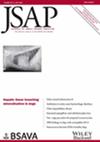Canine bilateral zygomatic sialadenitis: 20 cases (2000-2019)
Abstract
Objectives
To describe clinical findings, cross-sectional imaging features, management and outcome of dogs with bilateral zygomatic sialadenitis.
Materials and Methods
Clinical databases of three referral institutions were searched for dogs diagnosed with bilateral zygomatic sialadenitis who underwent magnetic resonance imaging or computed tomography of the head. Signalment, history, clinical, laboratory and imaging findings were reviewed.
Results
Twenty dogs with a mean age (±SD) of 7.1 (±2.7) years were included; Labradors were overrepresented (10/20). Common clinical signs included pain on opening the mouth (18/20), conjunctival hyperaemia (16/20), exophthalmos (15/20), periorbital pain (15/20), third eyelid protrusion (11/20) and resistance to retropulsion of the globes (11/20). Fifteen of twenty dogs had at least one concurrent systemic disease: skin allergy (5/15), hypertension (3/15), gastrointestinal (3/15), kidney (3/15), neurological (3/15) and periodontal disease (2/15), pancreatitis (2/15) and neoplasia (2/15). Neutrophilia (9/18) and leukocytosis (7/18) were the most common haematological abnormalities. When performed (11/20), aspiration cytology revealed predominantly degenerate neutrophils (9/11) and only 2/9 culture samples yielded bacterial growth. The zygomatic glands were predominantly hyperintense on both T1 and T2-weighted images (22/24) and symmetrically enlarged (20/24) with marked and heterogeneous contrast enhancement (18/24). In the computed tomography studies, the zygomatic glands were all hyperattenuating and contrast enhancing. Treatment included systemic antimicrobial (18/20), anti-inflammatory (14/20) and supportive treatment (16/20). Clinical signs improved in 16/20 dogs; however, 4/20 dogs were euthanised due to severe systemic disease.
Clinical Significance
Bilateral zygomatic sialadenitis is frequently associated with systemic disease in dogs. Clinical signs generally improve with systemic antimicrobial, anti-inflammatory and supportive treatment.


 求助内容:
求助内容: 应助结果提醒方式:
应助结果提醒方式:


